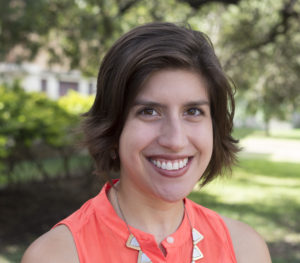“I think our society has adopted an unrealistic zero-tolerance policy about suicidality. We can diagnosis people with mental illness and prescribe them medication, but we need to examine how our culture and society are impacting mental health.”
The Hogg Foundation awards its annual Henry E. And Bernice M. Moore Fellowship of $20,000 to one doctoral candidate at The University of Texas at Austin whose dissertation research pertains to the mental health impact of crises, stress and adversity. Frances Fowler Wallace Memorial Awards of up to $1,500 are also distributed annually to graduate students that meet similar qualifications.
Hannah Szlyk is the first applicant to receive both the Moore Fellowship and Wallace Award. She recently completed her third year at the UT Austin School of Social Work.
What drew you to the School of Social Work at the University of Texas at Austin (SSW), and social work in general?
I actually became a social worker accidentally. The summer before my senior of college, I was interning at a refugee resettlement program in my home state of New Hampshire. I really enjoyed working with the newly arrived families and helping them adjust to life in the U.S. My advisor at the resettlement program suggested that I apply for a master’s in social work so I could continue working with families one-on-one. The following summer, I started my master’s degree at Columbia University.
I was first drawn to SSW while completing a post-masters clinical fellowship at the Menninger Clinic in Houston. I became involved in clinical research on eating disorders and suicide, and I wanted to continue developing research skills that had clinical implications for youth.
When did you first conceive of the project? What academic and professional experiences informed it?
I was hired as a contract social worker at Garza High School to assist with the mental health needs of the students. At Garza, I observed that many of the students demonstrated a range in suicidality, and that there was not a “one-size-fits-all” approach to helping them. Some exhibited signs of severe depression, anxiety and bipolar disorders, but many also appeared to demonstrate signs of suicidality that were reflective of life circumstances and social stressors.
While students at Garza have been identified by the school district as being at risk for drop out for multiple reasons — including homelessness, limited financial resources, histories of trauma, and family crises — the stressors and circumstances of these students are shared by many high school-age youths. Instead of focusing on co-occurring mental health issues, I wanted to examine how life stressors (housing mobility, life events, discrimination, neighborhood environment, school progress) contribute to and predict ranges in suicidality, and how the specialized program at Garza may help students stay safe and graduate.
What are the limitations of today’s mainstream suicidology literature, and how does your research methodology challenge them?
Research on suicidality has been historically dominated by studies on adult, white, heteronormative populations. The medical field also has a strong hold on which findings are mainstreamed, which means that few studies on diverse populations that use qualitative methods have reached broader audiences.
This combination of institutional barriers limits innovation of interventions for minority and underserved youth. Randomized controlled trials are considered the golden standard of intervention research, and translating their results to non-clinical or less-financially resourced community services can be difficult. The increase in suicide and suicidality over the past decade suggests that the prevention and intervention efforts of suicidologists need to be assessed.
My study includes a smaller sample of minority and underserved youth, and employs both quantitative and qualitative research methods. I use ecodevelopmental and cultural frameworks of suicide, rather than biomedical ones, to ground my work. My study site is also a public, non-clinical setting that has been sustainable for more than a decade.
What practical applications do you hope your research will bring to Garza and beyond?
Specifically, I hope the study can demonstrate that environment and social stressors contribute to youth suicidality, and need to be considered as important as (and possibly linked to) diagnoses of mental illness.
I hope the results can also demonstrate to laypeople and other researchers that there is a spectrum in suicidality. I think our society has adopted an unrealistic zero-tolerance policy about suicidality. We can diagnosis people with mental illness and prescribe them medication, but we need to examine how our culture and society are impacting mental health. Bigotry, discrimination, poverty, homophobia, immigration restrictions, violence and crime — even the perfect prescription cannot alleviate these issues for a person.
Additionally, I hope to show school districts and other administrators how a solution-focused program and campus culture can help keep students safe. Rather than send students to the ER every time death or self-harm is mentioned, programs like Garza’s will encourage their students to build coping strategies that help alleviate stress and adversity long after they graduate.

